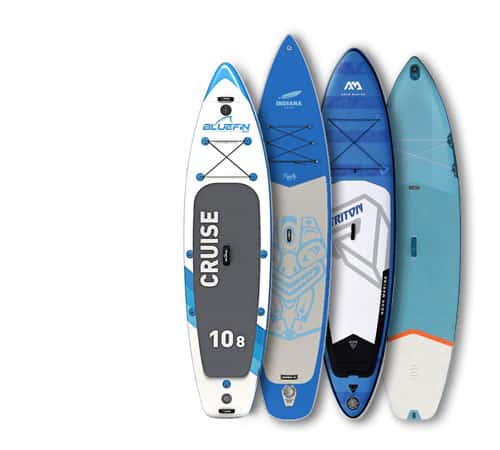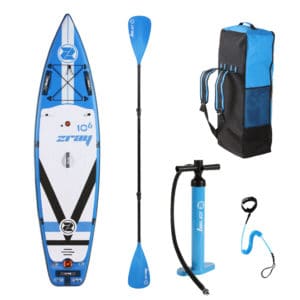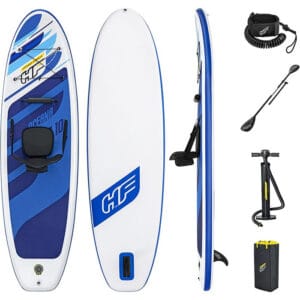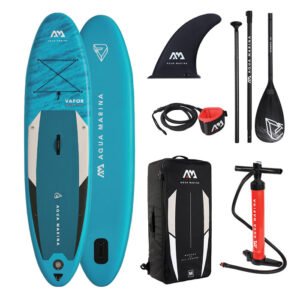When first looking into buying a SUP, all the technical terms and measurements in feet, inches, etc. can seem a bit overwhelming. But that’s not all, every change of one of these parameters causes an improvement in one area of performance, but at the same time a deterioration in another. With such a huge range of stand-up paddleboards, how can you find the right one for you?
Length + Width + Thickness = Volume & Load Capacity
A main feature of a SUP is the length of the board. Usually, as is customary in surfing, this is given in the absolutely mindless unit of measurement, feet. 1′ corresponds to approx. 30.48 cm.
Allround SUP boards, which we focus on in this test, usually have a length of about 10′ (304 cm) and more. Even if the differences between the lengths in the all-round board range are not too great, it is still good to know what influence they have on the driving behavior. Because length is a trade-off between the board’s maneuverability, tracking and speed.
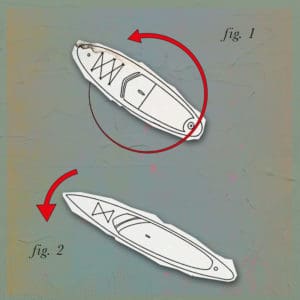
A short SUP board (fig. 1) is more maneuverable and generally less cumbersome in the water than a long one (fig. 2) due to an improved pivot point. Short, maneuverable boards are in demand on choppy, flowing waters as well as the waves. For this reason, there are special white water and wave boards.
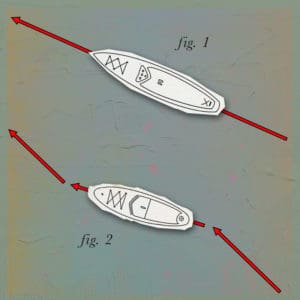
A long SUP board (fig. 1) cuts through the water at a constant width, similar to an arrow. The improved tracking means you don’t have to change paddle sides as much and the speed is generally higher. This effect is used in touring boards, which are built for long distances or the race boards for high speeds.
The width of the SUP primarily determines how safe the board is in the water. Of course, the wider the board, the larger the bearing surface, which leads to high tipping stability. This is probably one of the most important features of a board for beginners. Because nothing is as frustrating as constantly losing your balance and landing in the water. Therefore, in the beginning you should go for a SUP board with a width of at least 30″ (75-80cm). The faster you stand securely on the board, the faster you progress, which also improves your balance.
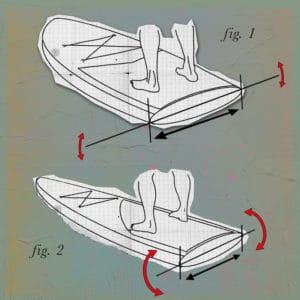
A wide SUP (fig. 1) has a large bearing surface and therefore lies particularly quietly in the water. A narrow (fig. 2) on the other hand is tippy and therefore more suitable for experienced paddlers.
Allround SUPs which are rather wide built are ideal for beginners and novices for this reason.
In thickness, the variety is somewhat less. Many SUPs these days are around 6″ (15cm) thick. But that was not always the case. Especially at the beginning of inflatable stand-up paddleboards were often thinner (+/- 10cm). However, it has been shown that good stiffness is difficult to achieve at this thickness and most boards have sagged in the water.

The stiffness of a board is given on the one hand by the construction and materials used and on the other hand by the thickness. Basically the thicker the SUP, the less it flexes. However, this also increases the resistance in the water somewhat.
From the interaction of the length + width + thickness results the hollow dimension of a SUP. This volume, usually given in liters, ultimately determines the load capacity, i.e. how heavy the paddler may be.
Many SUPs in the all-round range indicate a load capacity around 130kg or even more. This means that several paddlers can also travel together with the SUP. There are even huge special boards, which are made for 7-10 people.
SUP Board Shape
The shape of a board, has a significant influence on how the board will behave in the water. Just as the basic dimensions (length/width/thickness) are interdependent, the Shape is directly related to them. For a SUP board to float on the water with an adult person, a certain minimum volume is necessary. Thus, it is not possible to construct an extremely short, narrow and in the shape also tapered board on which an adult could paddle.
With this basic understanding, you can therefore see why the different SUPs look so different. A raceboard is narrow and has a pointed nose to minimize water resistance. So that it still has enough volume for the paddler, the race boards are built extremely long.
An all-round board, on the other hand, should be as short as possible so that it remains reasonably maneuverable, but has enough volume and a large contact surface so that it is also suitable for beginners to lie safely in the water. Thus, the all-rounders are built rather wide and round in the nose area (nose) and tail (tail). This way you can gain the maximum of wing area and volume.

A tapered nose, as opposed to a round one, behaves the same as the shape of a jet plane to a snowplow. The plow, the round shape, pushes through the water with a lot of displacement and is thus slowed down. The jet, the pointed SUP nose, on the other hand, cuts through the water like an arrow, making it more efficient and, in the end, faster.
In addition to the outer line of a SUP, you can also count the curvature (rocker) to the shape. Most stand-up paddleboards are shaped very flat in the standing area and then curve slightly upward in the nose area. The difference is not too big for most boards. Nevertheless, the expression of the nose rocker leads to slightly different driving behavior.
Construction of a SUP Board
The construction of a SUP has a significant influence on how stiff the board is. This means that it does not bend like a banana even under higher weight in the water. In addition, the construction, the quality of workmanship and materials used have an influence on how robust and therefore durable the board will be in the end.
Common defects, which can be found especially on somewhat cheaper SUPs, are glue residues on glued edges or small bubbles, which can be seen under the PVC layers. Of course, this does not mean that a board with these blemishes is not usable or that they will lead to damage after a short time. Rather, these minor flaws indicate workmanship that probably wasn’t exactly the same level of care as a high-quality more expensive board. Only time will tell if this somewhat simpler build quality will result in reduced longevity for the individual SUP board.
The way the SUP is constructed and the materials used have a big impact on another important factor besides performance and durability, weight. Nowadays, inflatable all-around SUP boards range from about 9-12kg.
Special Features
In addition to size and shape, SUPs often differ in other features, the most important of which we briefly highlight here.
- EVA-Pad: All boards have in common that a deck pad with a structure is glued on the surface. All boards have in common that a deck pad with a structure is glued on the surface.
- D-Rings: Are rings, which are attached to the deck of a SUP. These can be used to mount additional accessories. Partly a kayak seat is supplied, which is attached to these rings. The rings get their name from their shape. Flat on one side, rounded on the other, they strongly resemble a D.
- Luggage Net: Often a net of rubber cords is mounted on these D-rings in the bow area and sometimes additionally at the stern. This luggage net can be used to transport smaller items such as water bottles or drybags.
- Action Cam Mount: Action Cams such as GoPro’s or partly also classic cameras can be attached to these mounts via ¼-thread. With it, you’re guaranteed to never miss a great moment during a SUP excursion again.
Accessories
What’s especially nice about stand-up paddling is how little equipment you need, which makes practicing the sport much easier. Besides the board, only 3 things are essential. The pump, the paddle and the leash.
Fortunately, many of the beginner SUP boards come with these standard accessories right out of the box. Some even come in complete sets, with even more optional accessories that leave practically nothing to be desired.
The function of the pump itself is self-explanatory. Nevertheless, there are several variants. In contrast to the past, double-stroke pumps are usually supplied today. Compared to single stroke pumps, these not only pump air into the SUP when pushing down, but also when pulling up. This speeds up the process. Many SUP boards are inflated to 15 psi, which is equivalent to 1 bar. This takes between 5 and 12 minutes, depending on the physical effort.
Some pumps also have a suction function. By repositioning the hose, the last bit of air can be pumped out of the board, making packing much easier.
Stand-up paddling, of course, requires a paddle. This usually consists of several parts for easy transport and can be adjusted in length according to body size.
Most often, the entry-level sets include the slightly cheaper aluminum paddles. Unlike the expensive carbon or fiberglass paddles, these are about 500 grams heavier. What sounds like little is clearly noticeable after a long paddle tour with thousands of paddle strokes in the arms. On the positive side, however, this also means that the training effect is greater.
For a leisurely trip on the lake or splashing around in the water, such an aluminum paddle is good enough. However, if you have sporty ambitions, you will be happy to invest more money in a high-quality model in a second step.
The leash is the line that connects the body to the SUP board. It is strongly recommended to use them. Because, even a little wind can cause the SUP board to drift extremely quickly if you fall into the water, immediately creating a fire dangerous situation.
The leash is available in 2 different variants, on the one hand a simple cord and on the other hand a curled (coiled leash). The advantage of this coiled leash is that it is curled on the board and does not float in the water behind. This prevents the line from getting tangled in seaweed or rocks.
Fortunately, in addition to these 3 essential items, the SUP usually comes with a backpack. In this, the board can be rolled up and conveniently stowed and transported with the rest of the equipment. The quality of these backpacks sometimes differ greatly. Cheaper SUPs usually come in a rather simple design e.g. without much padding on the risers. High-quality sets, on the other hand, sometimes include backpacks with great carrying comfort and are sometimes even equipped with wheels.
Furthermore, local regulations must be observed, some of which require buoyancy aids or life jackets.
FAQ: The most common Stand Up Paddling questions
-
What is SUP and a SUP board?
SUP is the abbreviation for stand-up paddling, which already describes the sport pretty well. The SUP board is the surfboard on which it is possible to stand upright and move paddling even without moving forward.
Like the whole sport of surfing, the concept of standing paddling originated long ago among Polynesian fishermen.
In the 2000s, the sport of SUP has become increasingly independent of wind and wave riding.
With the development of inflatable SUP boards, also called inflatable SUP or iSUP, the handling and transport became much easier and thus enabled the wide spread as a recreational sport. -
For whom is stand-up paddling suitable?
Stand up paddling is suitable for practically everyone. Although some balance is required in the beginning, with the right board (wide and high tip stability) beginners can be standing and riding within the first hour. For many who already practice board sports or have a good sense of balance, it’s usually just stand on it and go.
Stand-up paddling is ideal for relaxed rides on the lake, but sporty paddlers also get their money’s worth with long tours or special race boards. The whole body is used equally and is therefore ideally suited for staying active and fit. -
What are the types of inflatable SUP boards?
Due to different requirements, depending on the use and waters, several board types have emerged and SUP categories formed.
Allrounder:
As the name suggests, all-rounder SUP boards can do everything a little bit and are therefore ideal especially for beginners. A wide, rounded design provides good tipping stability and balanced driving characteristics. They can be used on relatively calm waters such as lakes and rivers, and even in the sea if the waves are small.
Allrounder can thus be used in many ways, partly also in pairs or with a dog and are thus suitable for occasional & weekend paddlers who want to take relaxed short tours.
Touring-Boards:
With the touring boards, the slightly more pointed and longer design reduces water resistance. In addition to better straight-line stability, this allows higher speeds or extended tours with less effort. However, on the downside, they are also more difficult to maneuver and offer less tipping stability.
Race-Boards:
In the case of racing boards, the principle of touring boards, with the narrow, long construction is taken to the extreme in the truest sense of the word. Due to this shape, a race board cuts through the water like an arrow and enables top speeds. However, these boards are almost impossible to ride for beginners.
Wave-Boards:
These boards are rather a little shorter and wider built than eg Allrounder. This makes them a lot easier to turn and therefore ideal for riding higher waves.
White Water Boards:
These boards are designed to be exceptionally robust for fast, choppy waters. Also rather short they can turn almost on the spot, so you can navigate well in extreme white water passages. -
How much does a SUP board cost?
For a SUP board you can spend anything from 200 to 2000 Dollar. Where you can say that you can expect to buy a very good all-round SUP with about 500-800 Dollar.
-
What accessories are needed?
Essential is an air pump to inflate the iSUP, as well as paddle and leash.
In addition, most boards come with a storage or carrying bag. In addition to these standard accessories, there are a variety of extras that make stand-up paddling more comfortable or varied. From kayak seats to transport bag, speakers to electric pumps, you can find everything your heart desires. -
What should be considered when caring for the SUP board?
After use, the board should be briefly washed with clean water and allowed to dry before packing. Loosely rolled up, it is best stored in a cool, dry and shady place.
Also, be careful not to expose the board to direct sunlight for too long outside when not in use. The heat and UV rays can cause the material to become brittle over time.
For small repairs, most SUP boards come with a repair kit with glue and patch kit. -
On which waters can you stand up paddle?
Beginners should start out on waters that are as calm and windless as possible. With a little practice, you can then move on to more difficult ones. Because theoretically, stand-up paddling is possible on virtually any body of water. Whereas there are special wave boards for the sea and turbulent rivers whitewater boards.
However, the focus should always be on safety. You have to deal with the particular requirements (material & skills) and behaviors that are required on a specific body of water.
